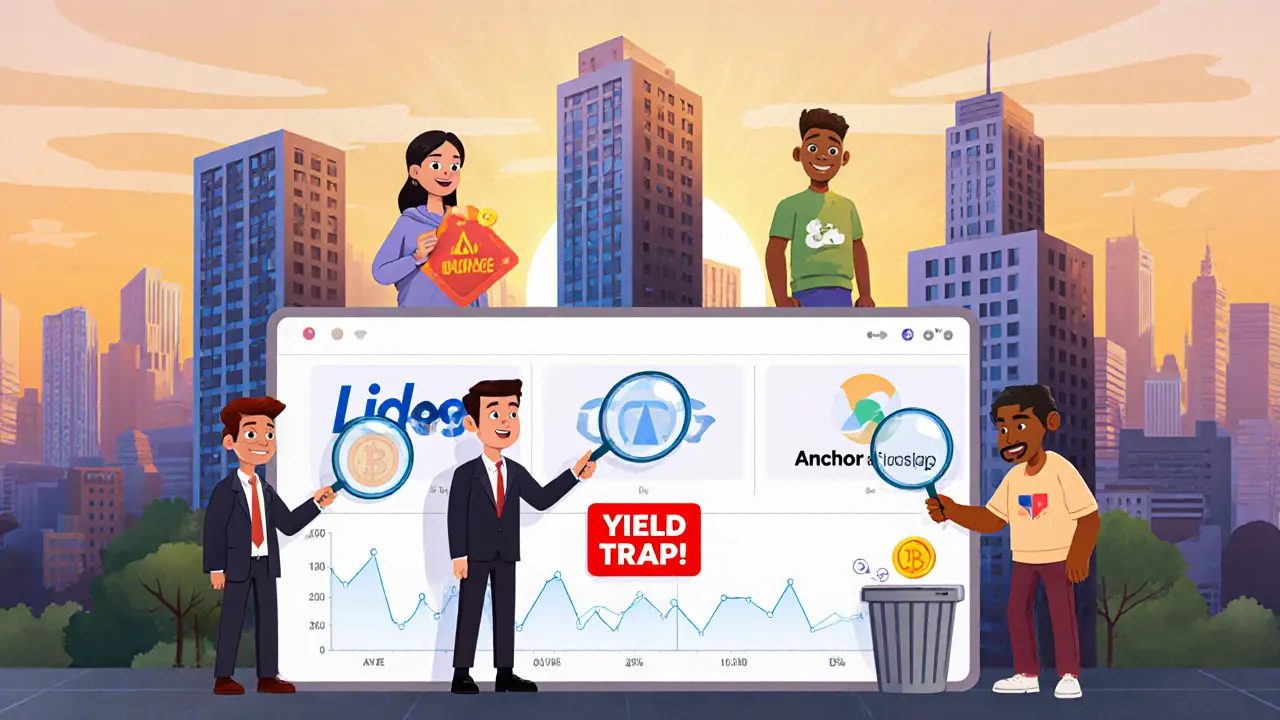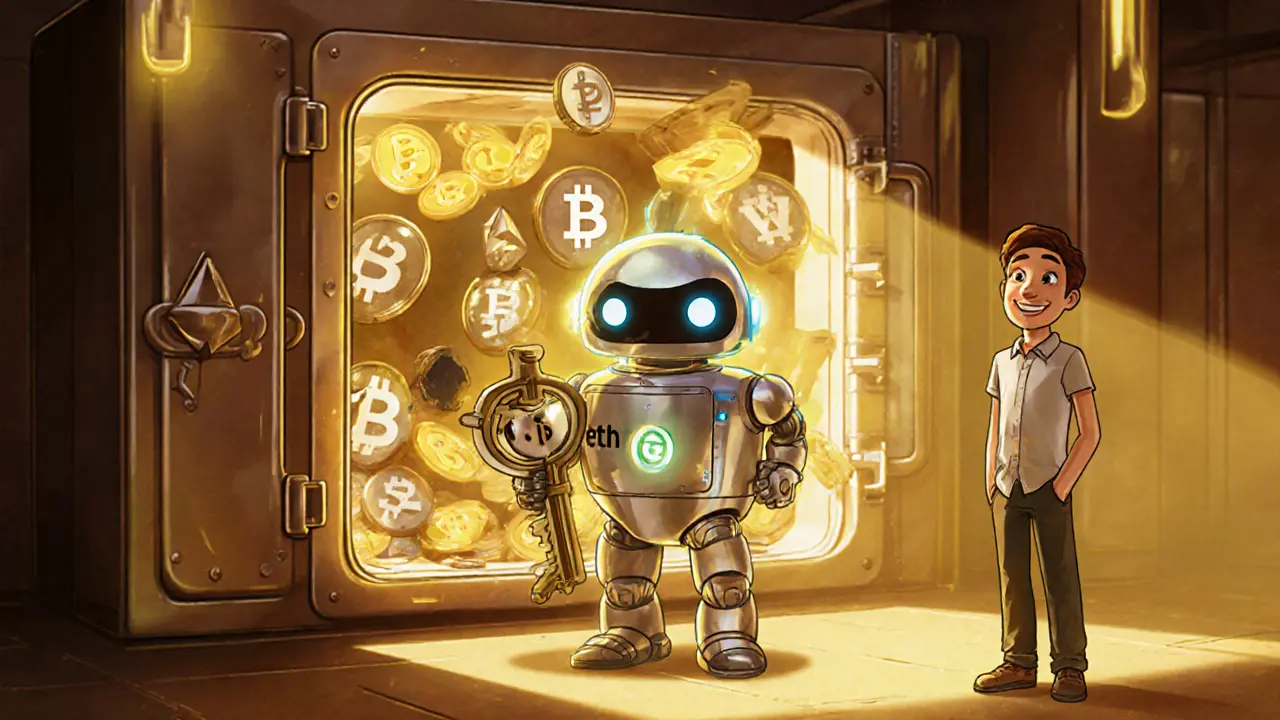DeFi Protocol Comparison Tool
Compare DeFi Protocols
This tool helps you evaluate top DeFi protocols beyond just TVL numbers. Select protocols to compare their key metrics, features, and risks as detailed in the article.
Select up to 5 protocols to compare
Protocol Comparison
Select protocols to view side-by-side comparison
Select protocols above to see comparison details
Key Insights
Why TVL Alone Is Misleading
- TVL doesn't measure safety, profitability, or sustainability
- Protocols can artificially inflate TVL with unsustainable yield incentives
- High TVL can be temporary (e.g., Anchor Protocol's $2.1B collapse in 2023)
- Only 31% of top DeFi protocols generate more fees than they spend
- Look beyond TVL to evaluate real user activity, revenue, and security
When you hear "DeFi" these days, you’re not just hearing about fancy crypto jargon-you’re hearing about real money. Over $142 billion is locked up in decentralized finance protocols right now, and that number keeps climbing. But not all of it is equal. Some protocols are just chasing high yields with short-term deposits. Others are building real financial infrastructure. The key to understanding what’s actually working? Look at Total Value Locked-or TVL. It’s not perfect, but it’s the best single metric we have to see where real capital is going.
What TVL Really Means (And Why It Matters)
TVL isn’t just a number on a dashboard. It’s the total amount of crypto assets-ETH, USDT, WBTC, you name it-that users have deposited into DeFi smart contracts. These aren’t just idle balances. They’re being used for lending, swapping, staking, or earning yield. Every dollar locked means someone trusted that protocol enough to move their money there. The catch? TVL doesn’t tell you if the protocol is safe, profitable, or sustainable. It just tells you how much cash is inside. Think of it like a bank’s total deposits. A big deposit total doesn’t mean the bank is well-run-it just means people are putting money in. In DeFi, that’s especially important because TVL can spike overnight when yield farmers chase 50% APYs, then vanish just as fast when those yields dry up. That’s why experts now look beyond TVL. They ask: How much revenue is this protocol generating? How many real users are active? Is the team using multi-sig wallets and getting audited? But if you’re trying to figure out where the biggest players are, TVL is still the starting point.The Top 5 DeFi Protocols by TVL (2025 Data)
As of mid-2025, here are the protocols leading the pack-and why they’re holding onto so much value.Lido: The Liquid Staking Giant
Lido leads with $13.9 billion in TVL across Ethereum, Polygon, and Solana. That’s more than most entire blockchains. How? It solved a huge problem: staking ETH used to lock your coins for months. You couldn’t trade them or use them elsewhere. Lido changed that. When you stake ETH with Lido, you get stETH in return-a token that represents your staked ETH and can be used in other DeFi apps. Need to borrow? Trade stETH. Want to earn yield? Deposit stETH into Aave. This flexibility made Lido the go-to for both retail and institutional stakers. But it’s not without risk. In March 2024, stETH briefly depegged from ETH during a banking crisis, spooking users. Still, 4.6 out of 5 stars from over 12,000 reviews shows most people trust it. And with Ethereum’s Pectra upgrade cutting staking fees by 37% in May 2025, Lido’s edge is growing.Aave: The Lending Powerhouse
Aave sits at $4.5 billion TVL across nine blockchains. It’s not the biggest, but it’s one of the most sophisticated. Unlike older lending platforms like Compound, Aave lets you borrow against collateral without needing to lock all your assets. Its "credit delegation" feature lets users lend their borrowing power to others-something institutional traders use to avoid posting extra collateral. During the 2024 market crash, Aave’s bad debt rate dropped 78% compared to Compound. Why? Better risk modeling and isolated lending pools. If one asset crashes, it doesn’t drag down the whole system. Users praise this-but they also complain about higher gas fees than Compound. Still, with v4 launching later this year to unify cross-chain pools, Aave is positioning itself as the central hub for multi-chain lending.MakerDAO: The Original Stablecoin Engine
MakerDAO’s Sky protocol holds $4.9 billion in TVL, almost all on Ethereum. Its secret? DAI, the most widely used decentralized stablecoin. DAI is backed by crypto collateral-mostly ETH-and maintains its $1 value through smart contract adjustments. If ETH drops too fast, the system automatically auctions off collateral to cover the debt. It’s complex, but it works. About 90% of MakerDAO’s TVL comes from users locking ETH to mint DAI. The borrowing rate is around 5.8% annually, which is low compared to other DeFi loans. But users report headaches: 41% said they got liquidated during ETH’s 35% drop in January 2025. The interface is clunky, and the collateral rules are hard to navigate. Still, DAI is used everywhere-from crypto exchanges to NFT marketplaces. That’s why MakerDAO remains essential.Uniswap: The Swap Leader
Uniswap’s TVL sits at $3.2 billion, spread across eight chains. It’s not the largest DEX, but it’s the most influential. Uniswap v3, launched in 2021, introduced concentrated liquidity-meaning liquidity providers can choose specific price ranges to deposit their funds. This made capital way more efficient. Now, Uniswap processes $18.7 billion in monthly volume with fees as low as 0.05%. Professional traders love it. New users? Not so much. Reddit threads are full of complaints about choosing the wrong price range and losing money to impermanent loss. Still, 68% of new users struggle with it, not because it’s broken-but because it’s powerful. And with over 458,000 members in r/Uniswap, the community is deeply engaged.Curve Finance: The Stablecoin Specialist
Curve has $2.1 billion TVL across 13 chains. It doesn’t try to do everything. It focuses on one thing: swapping stablecoins with minimal slippage. If you’re trading USDT for USDC or DAI for FRAX, Curve is the cheapest and fastest option. Its average fee? Just 0.04%. That’s why DeFi platforms like Convex Finance pump $1.7 billion into Curve to earn yield from its trading fees. But Curve has a reputation problem. Trustpilot ratings are the lowest among top protocols at 3.8/5. Why? 57% of negative reviews mention "impermanent loss confusion." Users don’t understand that even stablecoin swaps can lose value if the underlying assets diverge slightly. The documentation is technical, and the math isn’t beginner-friendly. Still, if you’re serious about stablecoin yield, Curve is unavoidable.
What’s Missing From TVL?
TVL tells you where money is. But it doesn’t tell you if it’s staying. In 2023, Anchor Protocol had $2.1 billion in TVL-mostly from artificial yields. When the yield collapsed, so did the TVL. It vanished almost overnight. That’s why experts are pushing for "TVL 2.0" metrics. These include:- Revenue generated per dollar locked
- Number of unique active users
- Security spending (audits, insurance, multi-sigs)
- Fee sustainability (are fees covering costs?)
Where the Money Is Coming From-and Where It’s Going
The biggest chunk of TVL-38.2%-is in liquid staking (like Lido). Another 29.7% is in lending (like Aave and MakerDAO). DEXs like Uniswap and Curve make up 19.4%. Together, those three categories account for nearly 90% of all DeFi value. Institutional money is creeping in. Fidelity, Fireblocks, and BlackRock’s BUIDL fund now hold $10.2 billion in tokenized assets-7.2% of total DeFi TVL. But here’s the twist: 78% of that institutional cash is in stablecoins, not volatile assets. They’re using DeFi for yield, not speculation. Meanwhile, regulatory pressure is shifting capital. The SEC classified 12 DeFi protocols as unregistered exchanges in early 2025. That pushed $18.3 billion out of centralized bridges and into non-custodial, permissionless protocols. The result? More decentralization, but also more fragmentation.
What You Should Do With This Info
If you’re new to DeFi, don’t chase the highest TVL. Don’t assume big numbers mean safety. Instead:- Start with Lido if you want to stake ETH without locking it up.
- Use Aave for lending or borrowing with lower risk than older platforms.
- Stick to MakerDAO if you need DAI-but only if you understand collateral rules.
- Trade stablecoins on Curve for low fees.
- Use Uniswap v3 only if you’re comfortable setting price ranges.
What’s Next for DeFi TVL?
Analysts predict TVL will hit $210-240 billion by 2026. But growth won’t come from hype. It’ll come from real utility. EigenLayer’s restaking tech, which lets ETH stakers secure other protocols, could add $8 billion more by Q3 2025. Aave’s v4 will simplify cross-chain lending. And Ethereum’s ongoing upgrades are slowly bringing gas fees down. The real winners won’t be the ones with the biggest TVL today. They’ll be the ones building systems that can survive when the yields disappear-and the users still need them.What is TVL in DeFi?
TVL stands for Total Value Locked. It’s the total amount of cryptocurrency deposited into a DeFi protocol’s smart contracts, measured in USD. It’s used to gauge how much trust and capital a protocol has attracted, but it doesn’t measure safety, profitability, or long-term sustainability.
Is a high TVL always a good sign?
No. A high TVL can mean strong adoption-or it can mean people are chasing temporary high yields. Some protocols artificially inflate TVL by offering unsustainable rewards. When those rewards stop, users pull their money out fast. Always check revenue, user activity, and security audits alongside TVL.
Which DeFi protocol has the highest TVL in 2025?
As of mid-2025, Lido leads with $13.9 billion in TVL across Ethereum, Polygon, and Solana. It dominates because it lets users stake ETH and still use their staked assets elsewhere via stETH, a liquid staking derivative.
Why is Lido’s TVL so much higher than Aave’s?
Lido’s TVL is higher because it captures the entire Ethereum staking market, which is massive. Staking ETH is required to run the network, and Lido makes it liquid. Aave is a lending platform-only a portion of users lend or borrow. Lido’s model attracts both retail and institutional stakers who want to earn yield without giving up liquidity.
Can TVL be manipulated?
Yes. Protocols can incentivize deposits with fake yields, borrow their own tokens to inflate balances, or use cross-chain bridges to move funds temporarily. The 2023 collapse of Anchor Protocol-where $2.1 billion in TVL vanished after yield incentives ended-is a prime example. Reputable platforms like DefiLlama now use multi-oracle price feeds and audit logs to reduce manipulation.
How do I track my own TVL across different DeFi apps?
Use a portfolio tracker like Zapper.fi or DeFiLlama’s wallet dashboard. These tools connect to your wallet and pull data from multiple protocols to show your total locked value across lending, staking, and liquidity pools. They also show your earnings and risks in one place.

Vanshika Bahiya
November 14, 2025 AT 10:31Lido’s stETH is honestly a game-changer. I started staking through them last year and never looked back. Being able to use my staked ETH in Aave, Uniswap, even as collateral for loans? That’s DeFi working the way it should. No more sitting on locked-up coins while everyone else is earning. And the Pectra upgrade just made it even sweeter-lower fees, more liquidity. If you’re new to staking, start here. No capes needed, just common sense.
Albert Melkonian
November 15, 2025 AT 06:00While TVL remains a useful heuristic, I would strongly encourage a more rigorous analytical framework that incorporates protocol revenue, user retention metrics, and audit transparency. The collapse of Anchor Protocol serves as a cautionary tale regarding the dangers of conflating capital inflow with systemic integrity. A protocol with $10 billion in TVL but negative net revenue is not a success-it is a liability waiting to be unwound.
Kelly McSwiggan
November 16, 2025 AT 01:38TVL? LOL. You mean the number that every rug pull uses to convince dumb money to throw their ETH into a black hole? Lido’s ‘stETH’ is just a fancy IOU that’ll vaporize the second ETH drops 40% again. And don’t get me started on MakerDAO’s liquidation nightmares. People treat this like a bank, but it’s a casino where the dice are loaded with smart contracts written by 19-year-olds who think ‘decentralized’ means ‘no consequences.’
Byron Kelleher
November 17, 2025 AT 09:27Big respect to everyone putting real effort into building this stuff. I’m still learning, but I’ve been using Aave for lending and it’s been solid. Yeah, gas is annoying, but at least I’m not losing sleep over it. And Curve for stable swaps? Absolute butter. Don’t let the haters scare you off-just start small, use Zapper to track it, and keep your eyes open. DeFi’s messy, but it’s also the future. We’re all figuring it out together.
Cherbey Gift
November 18, 2025 AT 04:54Ohhh, TVL-this glittering temple of digital devotion where mortals toss their crypto into the void, whispering incantations of ‘APY’ to the blockchain gods! But tell me, oh seeker of yield-when the stETH oracle weeps and the DAI peg trembles like a leaf in a hurricane, who shall sing the dirge of the lost liquidity? Is it not the same hands that once danced with Uniswap’s concentrated pools, now clutching empty wallets and the hollow echo of ‘impermanent loss’? The machines do not love us. They only reflect our greed, our desperation, our fragile belief that algorithms can be trusted with our dreams.
Anthony Forsythe
November 19, 2025 AT 22:01Let me tell you something-this isn’t just about numbers on a screen. This is the quiet revolution of human trust being rewritten in code. Every dollar locked in Lido, every DAI minted in MakerDAO, every swap on Curve-it’s not finance. It’s philosophy. It’s the death of the banker’s monopoly, the birth of a new covenant between man and machine. And when the regulators come with their subpoenas and their compliance forms, they won’t understand. They’ll see a ledger. But we? We’ll see the dawn of economic sovereignty. The old world is crumbling. And we? We’re the ones holding the keys.
Kandice Dondona
November 20, 2025 AT 18:47YES!! 😍 I’ve been using Lido + Aave combo since last year and it’s been smooth sailing. stETH is like magic money that earns while it sleeps 🌙💸 And Curve? Best stable swap ever. Just don’t touch Uniswap v3 unless you’ve got a math degree 😅 Zapper.fi saved my sanity-my whole portfolio in one tab! DeFi’s wild but so worth it if you play smart. 💪✨
Becky Shea Cafouros
November 21, 2025 AT 14:51TVL is a misleading metric. It’s been abused for so long that it’s become meaningless without context. If you’re investing based on this alone, you’re not an investor-you’re a spectator at a fireworks show that’s about to blow up in your face. I’ve seen too many people lose everything chasing the highest number. Do your homework. Check audits. Look at revenue. Don’t just follow the crowd.
Drew Monrad
November 23, 2025 AT 10:31Oh, so Lido’s the ‘giant’ now? Cute. Let me guess-next you’ll tell me the SEC’s ‘regulation’ is a good thing. You know what’s really happening? Institutions are using these protocols as tax-efficient yield farms while retail gets stuck holding the bag when the rug gets pulled. And don’t even get me started on how ‘decentralized’ these platforms are when 80% of the liquidity comes from a handful of whale wallets. This isn’t finance. It’s a corporate front for crypto laundering. Wake up.
Cody Leach
November 24, 2025 AT 23:01Just wanted to add that if you’re using Zapper.fi, also check DeFiLlama’s wallet tracker-it’s got better breakdowns for multi-chain exposure. I had $20k stuck in a Polygon pool I forgot about until it showed up there. Also, if you’re new, stick to ETH and USDC for now. Don’t touch weird stablecoins like FRAX or FEI until you’ve read the whitepaper twice. DeFi’s cool, but don’t rush it.